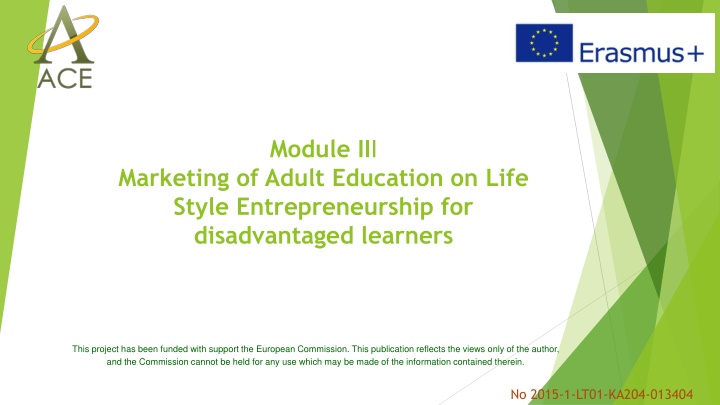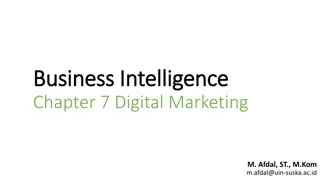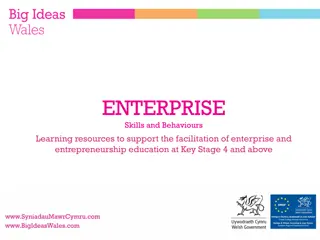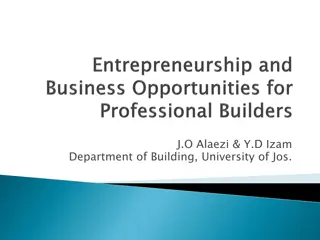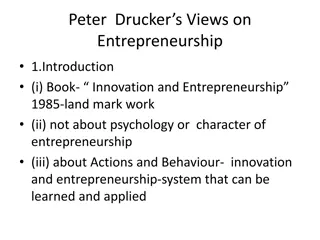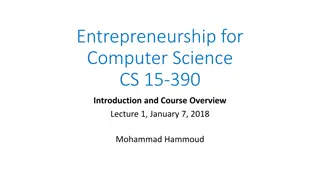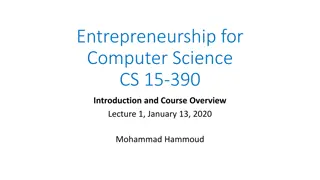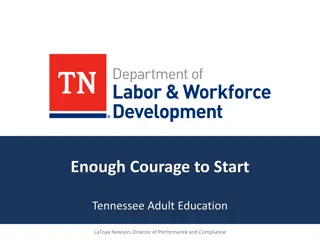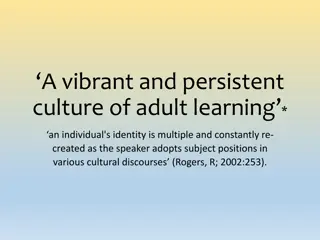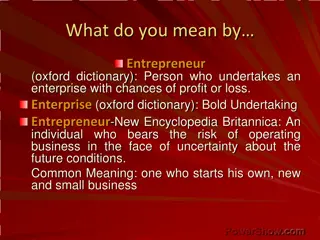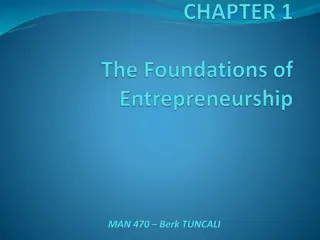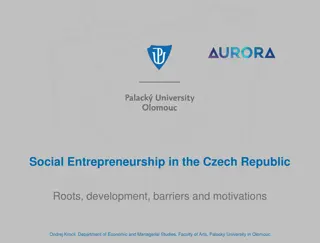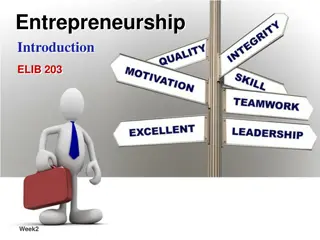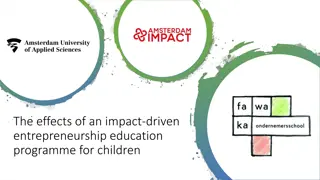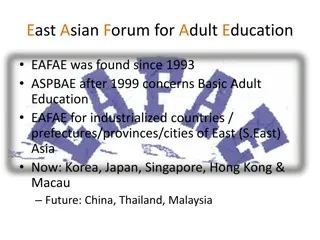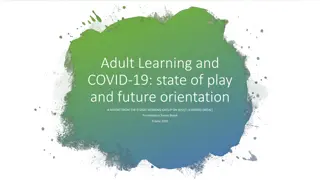Marketing Strategies for Adult Education in Entrepreneurship
This project focuses on developing marketing competences for adult educators to engage disadvantaged learners in lifelong learning and entrepreneurship training. The aim is to empower learners through effective marketing strategies and communication channels, highlighting the social and psychological aspects of working with disadvantaged groups. By the end of the module, educators are expected to apply principles of adult education marketing, utilize various communication tools, and motivate learners for self-employment.
Download Presentation

Please find below an Image/Link to download the presentation.
The content on the website is provided AS IS for your information and personal use only. It may not be sold, licensed, or shared on other websites without obtaining consent from the author.If you encounter any issues during the download, it is possible that the publisher has removed the file from their server.
You are allowed to download the files provided on this website for personal or commercial use, subject to the condition that they are used lawfully. All files are the property of their respective owners.
The content on the website is provided AS IS for your information and personal use only. It may not be sold, licensed, or shared on other websites without obtaining consent from the author.
E N D
Presentation Transcript
Module III Marketing of Adult Education on Life Style Entrepreneurship for disadvantaged learners This project has been funded with support the European Commission. This publication reflects the views only of the author, and the Commission cannot be held for any use which may be made of the information contained therein. No 2015-1-LT01-KA204-013404
The aim of Module III To develop adult educators-practitioners competences to use different marketing strategies in order to motivate disadvantaged adult learners for active participation in lifelong learning and in training on LSE No 2015-1-LT01-KA204-013404
The objectives of the Module III introduce the basics and peculiarities of adult education marketing; review different marketing tools and communication channels as well as of their availability in training on LSE; present the social and psychological aspects of working with disadvantaged groups and empowering them to be active in social and economical life. No 2015-1-LT01-KA204-013404
Learning outcomes By the end of Module III the adult educator practitioner will be able to: describe the basic and specific principles of adult education marketing in particular working with disadvantaged learners; apply different adult education marketing strategies and communication channels by organizing training courses; analyze the social, psychological peculiarities of disadvantaged people and motivate them to learn and to get self-employed No 2015-1-LT01-KA204-013404
In the General part of the Module III the following topics are presented: The basic and specific principles of adult education marketing in particular working with disadvantaged learners; The different marketing tools and communication channels as well as of their availability in training on LSE No 2015-1-LT01-KA204-013404
What is marketing? In simple impressing a person to buy the product/service. In detail - Marketing is the function of any organization or program whose goal is to plan, price, promote, and distribute the organization s programs and products by keeping in constant touch with the organization s uncovering their needs and expectations for the organization and themselves, and building a program of communication to not only express the organization s purpose and goals, but also their mutually products. (Philip Kotler). various constituencies, beneficial want-satisfying No 2015-1-LT01-KA204-013404
Non-formal adult education is a specific part of the service business area: at the same time it is both the work and the result; it has particular characteristics (intangibility, inseparability, perishability, heterogeneity). No 2015-1-LT01-KA204-013404
Characteristics: Intangibility Education is impossible to Touch Taste Feel See No 2015-1-LT01-KA204-013404
Characteristics: Inseparability This means that the services are created and used at the same time and cannot be separated from service providers, that is people or equipment (Kotler&Keller, 2007) Teacher Adult learner No 2015-1-LT01-KA204-013404
Characteristics: Heterogeneity It means that is impossible to provide the education service for every learner in the same way because it is provided at a different time and in different conditions No 2015-1-LT01-KA204-013404
Characteristics: Perishability As education service is intangible, it is impossible to accumulate its stock No 2015-1-LT01-KA204-013404
Service marketing is: Oriented to profit Oriented to needs Noncommercial Commercial No 2015-1-LT01-KA204-013404
Marketing types Noncommercial marketing Marketing of Non- profit Organisation Social marketing No 2015-1-LT01-KA204-013404
Education service marketing complex consists of main parts No 2015-1-LT01-KA204-013404
Additional parts of Adult Education service marketing People Physical evidence Process No 2015-1-LT01-KA204-013404
The structural parts of marketing plan goal of the marketing on LSE training presentation of LSE courses service analysis of learners from disadvantaged groups pricing place promotion budget expenditures for implementation of marketing plan action plan No 2015-1-LT01-KA204-013404
Marketing Tools and Communication Channels
Marketing communications Marketing communications are the means by which organizations attempt to inform, persuade, and remind consumers directly, or indrectly about the products and services that they sell (Kotler and Keller) No 2015-1-LT01-KA204-013404
Marketing is strategic communications and promotions delivered in a mix of forms: advertising public relations personal sales sales promotion direct marketing interactive/internet marketing Word-of-mouth marketing Successful experiences (success stories)
Advertising Advertising is designed to reach the public and motivate them to become more interested in the subject matter of the advertisements Commercial vs non-commercial advertising Medium: TV (costly) Print (newspapers and magazines) and Radio (fewer people) Print Mail (flyers, brochures, posters, letters) (cost is reasonable, large audiences) The Internet: Google, Facebook, LinkedIn (cost is reasonable, large audiences) Social media (most cost efficient) Signs and billboards (costly) No 2015-1-LT01-KA204-013404
Features of good advertisement Memorable Easily recalled Provides information quickly and succinctly Doesn t confuse the learner Calls the learners to action No 2015-1-LT01-KA204-013404
Advertising: Know your target market Although advertisement is meant to address thousands of people, it should remain individual as if it applies to a certain person. Target group determines the message: rational (facts, arguments, quotations) emotional (inspiring) No 2015-1-LT01-KA204-013404
Advertising: Headlines aims to capture the consumer s attention in order to engage him; focuses on the target group s problems is short, readable at a glance Do you have a talent, but don t have a job? Choose a job, not a dole. We ll help you Do you want to change your life? How about making your hobby into a profession? No 2015-1-LT01-KA204-013404
Public relations is the practice of planned and continuous managing of the spread of information between the organization and its environment by which organization seeks to create and maintain good will and mutual understanding. Means of communication with the public: The news Informational/Feature articles Public speeches Special events, Brochures, video and audio material (at libraries, health centres, schools, banks, municipality centres, etc.) True-to-life success stories No 2015-1-LT01-KA204-013404
Personal selling Channels: Face-to-face Over the telephone Through e-mail SMS messaging Advantages: Helps to create long-time relationships Most effective, but also the most expensive tool No 2015-1-LT01-KA204-013404
Word of Mouth Word-of-mouth just like Public Relations is a free marketing strategy, which helps to spread information about products and services It is not a planned marketing activity, but it might help a business to build a loyal client base. No 2015-1-LT01-KA204-013404
Internet/ Digital marketing Website Social media Mobile applications Advantages: Traditional media is one-way, social media are dialogues If your guess is wrong, you can change the media mix quickly, which helps to save time and money The impact can be measured quickly (Facebook, Twitter) The most cost-effective tool No 2015-1-LT01-KA204-013404
Digital marketing: it is worthwhile taking the advantage No 2015-1-LT01-KA204-013404
Online Tool for Creating Social Media Http://www.socialmediaexaminer.com How to use ads on the youtube channel; How to create and exploit Facebook: run contests, design ad campaigns, and analyze the results of your efforts; How to use Twitter ads; How to create social videos with your Smartphone; How to market your business on Instagram; How to master marketing on the Pinterest platform; How to start a business blog. No 2015-1-LT01-KA204-013404
In the Specific part of the Module III the following topic is presented: The social and psychological aspects of working with disadvantaged groups and empowering them to be active in social and economical life No 2015-1-LT01-KA204-013404
Social and psychological aspects of working with disadvantaged groups Dealing with the disadvantaged people adult educators practitioners need to take into consideration the psychological and social characteristics. motivate them to learn and involve them to labour market using the LSE idea The term people with disadvantaged backgrounds and fewer opportunities is explained under the Erasmus+ Programme as people with/ facing: mental, physical, sensory or other disabilities educational difficulties economic obstacles cultural differences geographical obstacles health problems social obstacles
Five practical strategies suggested by the psychologist Kierka For educationally disadvantaged, - low self-confidence 1. help learners set realistic goals and expectations, offer support services, such as mentoring and counselling For the socially disadvantaged 2. use word-of-mouth and door-to-door recruiting, distribute program information as inserts in store purchases, pay checks, or telephone bills, or flyers sent home with schoolchildren; increase the visibility of the program through community service projects; provide opportunities for the academic and social integration of learners .
Five practical strategies suggested by the psychologist Kierka For those facing situational barriers 3. offer learning programs in accessible neighbourhood locations with flexible scheduling to fit adult life-styles, arrange transportation (e.g., car pools) and child care for single parents . For adults having negative attitudes 4. advertise success stories of learning and entrepreneurship ; emphasize the difference between adult formal and non-formal education. For adults with low personal priority 5. focus on employment and employability skills, job survival; give value for money in terms of education, services (Kierka, 1988).
How to work with people facing economic obstacles (Brandi)? These are the main tasks for adult educator as advisor/facilitator and counsellor: Establish a positive relationship with the learner Set high expectations Do counselling and monitoring during the learning progress Carefully select the learning materials and decide on the tools of instruction and support
Culturally disadvantaged learners The adult educator should: be particularly sensitive and get acquainted with the target group s expectations; try to tailor the program to meet the group s needs; develop his/her cultural competence in order to value diversity; Develop a strategic approach to ensure that the needs of people from ethnic minority communities are not forgotten
People with health problems - physical or mental disabilities People with disabilities: often lack self-belief severity, particularly those with mental health issues. 1. often need more guidance and support 2. The adult educator has to be able to encourage people with impairments by: informing them about the possibilities of self-employment 1. providing the disabled future entrepreneurs with advice and support, 2. building their self-confidence to get self-employed or to start their own businesses.
Learners facing geographical barriers Such learners may lack self-study skills, thus the teacher should guide them through their learning until the learners become more skilled and can manage their own learning. However, the adult teacher should be aware that ICT by itself will not make a difference, unless it is used purposively to supplement, support and reinforce the learning process. The reversed/flipped learning approach should be used to the full extent.
Encouraging Disadvantaged People Entrepreneurship education is not just about teaching someone to run a business. It is also about encouraging creative thinking and promoting a strong sense of self-worth and accountability This entrepreneurship education includes: Becoming autonomous; The ability to recognize opportunities in one s life; The ability to pursue such opportunities by generating new ideas and marshaling needed resources; The ability to create and operate a new venture; The ability to think in a creative and critical manner (Entrepreneurship education, 2011).
